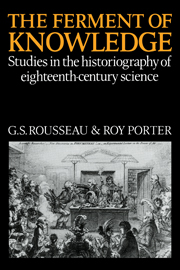Introduction
Published online by Cambridge University Press: 03 May 2010
Summary
In my experience, almost all erroneous views of what went on in the 19th century are related to particular ideas as to what went on in the 18th century; and for the history of science and the history of ideas in the 18th century you can trust almost no one. The amount of ‘hard’ history of science for that period is so lacking that one simply leaps … from Newton in optics to Young in optics. Who else observed what, how well, and how thoroughly, and with what results? It is hard to tell. It is no reproach to my friends who are trying to do something with the 18th century to tell them that their labors have not yet reached the point at which a 19th century historian can confidently go ahead from the stable platform they have erected. And the same is emphatically true of the history of ideas related to the history of science.
With these trenchant words, Susan Cannon has recently placed a bomb under the whole state of scholarship of eighteenth-century science. What lies behind these devastating criticisms?
The last generation has wrought a revolution in the history of science. As it was written thirty years ago, history of science, with honourable exceptions, essentially celebrated the biography of humble genius and the triumphal progress of discoveries along the royal road of truth. The history of science was the spaniel of science itself.
- Type
- Chapter
- Information
- The Ferment of KnowledgeStudies in the Historiography of Eighteenth-Century Science, pp. 1 - 8Publisher: Cambridge University PressPrint publication year: 1980
- 1
- Cited by



